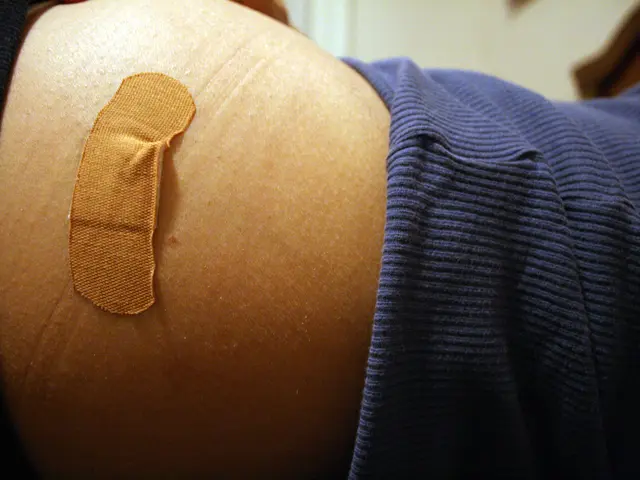Migraines: A Shift in Treatment Approach with Ubrogepant
Drug treatment revolutionizes migraine management
A groundbreaking medication, Ubrogepant, is making waves in the realm of migraine treatment. Originally approved in the US for the acute treatment of migraines, this drug has shown promising results in alleviating precursors to migraine attacks, known as the prodromal phase, according to a recent analysis.
Researchers have discovered that, during the prodromal phase, Ubrogepant can improve symptoms like light sensitivity, fatigue, and pain in the neck area in many individuals. This drug has been available in the US for some time, but Europe is yet to approve it. Ubrogepant belongs to the group of gepants or CGRP receptor antagonists, a relatively new class of drugs that block a messenger substance involved in migraines.
Two preparations from this group are currently approved in Europe, with Atogepant being a notable choice for the prophylaxis of migraines in Germany. However, Ubrogepant's potential to tackle the prodromal phase is a significant development in migraine treatment.
In the original approval study for Ubrogepant, participants either took 100 milligrams of the drug or a placebo when they suspected an impending migraine attack. The study aimed to determine whether the drug prevented headaches. After its approval in the US in 2019, the research team focused on whether taking the drug in the early hours could also improve the prodromal symptoms.
The study revealed that two hours after taking the active ingredient, light sensitivity improved or disappeared in 19.5% of participants, compared to 12.5% in the placebo group. Around 27% were no longer unusually tired 3 hours after taking Ubrogepant, compared to around 17% with placebo. Furthermore, around 29% had a significant improvement in neck pain 3 hours after taking the active ingredient, compared to around 19% in the control group. And 4 hours after taking the active ingredient, around 51% were less sensitive to noise, compared to around 36% with placebo.
Christian Maihöfner, chief physician of the Neurological Clinic at Klinikum Fürth, who was not involved in the work, stated that these drugs are very effective for some people. The publication is an extended analysis of a study whose primary endpoint was preventing migraine headache itself.
The well-designed and thorough study, as emphasized by the speaker of the Commission on Pain of the German Society of Neurology (DGN), provides clear indications for the improvement in prodromal symptoms for many migraine patients. With Ubrogepant's positive effects on early migraine symptoms, a "paradigm shift" seems to be indicated, moving away from exclusive acute treatment during the pain phase and towards targeted intervention during the early stages of migraines. However, further studies are required to confirm this approach's regulatory establishment.
Migraines: More Common in the North, With the Cold Came the Headache
Migraines are far more than "just" a headache and can be very debilitating. Many people experience severe symptoms even days or hours before an attack. Unfortunately, there are currently no specific therapies for the prodromal phase. The prodromal phase precedes a migraine attack in about 30 to 50 percent of cases, hours to days in advance. It is associated with symptoms such as fatigue, cognitive and concentration problems, pain in the neck area, and increased sensitivity to light and noise.
Recent studies and developments on ubrogepant for treating migraine precursors during the prodromal phase show promising results in alleviating early migraine symptoms before the headache begins, representing a substantial advancement in migraine treatment. Treating prodromal symptoms may improve patients' quality of life by reducing the full migraine attack's intensity or frequency.
The Storm in the Head: New Means Against the Common Disease Migraine
A paradigm shift is indicated: "Away from exclusive acute treatment in the pain phase and towards targeted intervention in the early stage of migraines." The approach will be established based on further, methodologically robust studies.
- With the positive effects of Ubrogepant on early migraine symptoms, such as light sensitivity, fatigue, and neck pain, a shift in treatment approach may be necessary, moving from acute treatment during the pain phase to targeted intervention during the prodromal phase.
- The advancement in medical-conditions research, particularly therapies-and-treatments for neurological-disorders like migraines, offers hope for individuals experiencing illnesses during the prodromal phase, as new promising solutions, such as Ubrogepant, emerge through science.
- As migraines affect an estimated 30-50 percent of sufferers in the prodromal phase, with symptoms including increased sensitivity to light and noise, fatigue, and cognitive issues, education and awareness about the benefits of early treatment options, like Ubrogepant, can contribute significantly to overall health-and-wellness and a better quality of life for those suffering from this debilitating condition.








